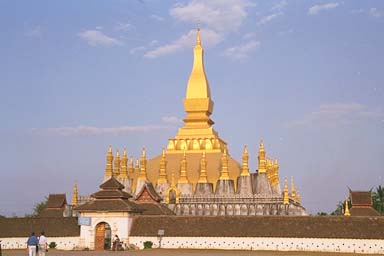| About Us | Site Map | Contact Us |
|
|
| Home | Schools & Teachings | Dharma Centers | Buddha & Bodhisattva Directory | Cosmos |
|
|
Laotian Buddhism
|
The faith was introduced beginning in the 8th century by Mon Buddhist monks. In 1353, after Laos had been ruled by Khmers from Angkor, then by Thais from Sukhothai, a Lao prince Fa-Ngum returned from exile in Cambodia to establish a kingdom called Lane Xang, or the Kingdom of the "Million Elephants". This King invited his Buddhist teacher at the Khmer court to act as his advisor and chief priest, brought with him a sculpture of the Buddha standing, and makes Theravada the national religion as it has remained to the present day. From the very beginning, Laos seems to have been barely strong enough to maintain a separate identity from its more powerful neighbors, such as Thais, Burmese and Vietnamese. Around the late 14th century, Subservient alliances with Burma and Thailand and had the effect of reinforcing Theravada Buddhism. Theravada Buddhism thus held together the numerous ethnic groups and inaccessible villages scattered through the mountainous countryside. King Visun (r. 1501-20) brought to fruition an ambitious Buddhist construction program, which had been begun by his two older brothers in order to repair damage done by the Vietnamese in the previous century. Around 1548, Burmese expansionism forced King Setthathriat (r. 1548-71) to form an alliance with the Thais in 1560. And forced the king to move the capital from Luang Phrabang to Vien Chan, a site closer to the Thai capital at Ayutthaya and more conducive to supervision by the Thais. Setthathriat did for Vien Chan was to carry out a large-scale Buddhist construction program. In 1575, the Burmese occupy Vien Chan and stay for seven years. After two parallel Laotian kingdoms had developed in Luang Prabang and Vieng Chan, they were reunited in 1591 under King Nokeo Koumane. In 1700 Laos breaks up into three kingdoms: Luang Prabang (Northern Kingdom), Vieng Chan and Champassak (Southern Kingdoms). After the Siamese (Thai) capital Ayutthaya had been conquered and sacked by Burmese armies, Laos again falls under full Burmese rule in 1767. In 1778, Thailand conquered Vien Chan and asserted control over Luang Prabang. The Siamese kingdom, with its new capital Bangkok, grows stronger and Laos again has to obey Siamese overlords. In 1827 the Laotians under King Anou rebel against the Siamese but are soon defeated. The Laotian State disintegrates. In 1886 France receives permission from Siam largely ruling Laos, to install a vice consulate in Luang Prabang. In 1887, Siam, anticipating French expansion, vacates large parts of Laos. In 1893 France declares the Mekong the official border between Laos and Siam. Laos was officially under French protection. Briefly during World War II, Laos was nominally independent under Japanese control. After World War II, in 1946, reassertion of French control in southeast Asia led directly to the formation of a communist independence movement under Ho Chi Minh. The French collapse in Southeast Asia in 1954 led to a coalition government in which both Lao royalists and Lao communists were represented. From 1964 to 1973 the US fight with Laotian communists as well as North Vietnamese. After the defeat of American forces in Vietnam in 1975, the communists quickly gained control in Laos. Since 1975 the communist government has not opposed Buddhism but rather has attempted to manipulate it to support political goals, and with some success. Since then, monks have been required to perform productive roles in the community. In addition to teaching Buddhism, monks have a significant responsibility for teaching literacy and history. Monks are also required offering the relief of illness; this includes the spiritual blessings and actual medical practices. |
| About Us | Free Books | Site Map | Contact Us | ||
| Copyright © 1999-2020 Manjushri. All Rights Reserved. | ||

 Buddhism has been the state religion of the Kingdom of Laos, and the organization of the Buddhist community of monks and novices, the clergy (sangha), paralleled the political hierarchy.
Buddhism has been the state religion of the Kingdom of Laos, and the organization of the Buddhist community of monks and novices, the clergy (sangha), paralleled the political hierarchy.